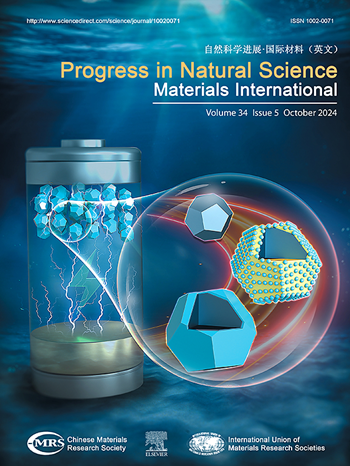高强度钛合金的组织设计、加工及强化机理研究进展
IF 7.1
2区 材料科学
Q2 MATERIALS SCIENCE, MULTIDISCIPLINARY
Progress in Natural Science: Materials International
Pub Date : 2025-04-01
DOI:10.1016/j.pnsc.2025.01.005
引用次数: 0
摘要
高强度钛合金(HS-TAs),特别是极限抗拉强度超过1100mpa的钛合金,在航空航天和其他先进工程领域发挥着至关重要的作用。然而,面对不断变化的产业格局和日益复杂的应用环境,HS-TAs的研发面临着前所未有的挑战。本文综述了近年来HS-TAs领域的重要研究进展,重点介绍了HS-TAs在微结构设计、加工技术和强化机制方面的最新进展。首先,本文综合评价了合金元素和非合金元素如何在微观尺度上精确控制α和β相的分布和形态,以及它们对钛合金力学性能的影响。随后,从塑性变形和微观组织调控的角度探讨了固溶强化、晶界强化、析出强化等多种机制对高强钛合金性能提高的贡献。此外,还比较分析了不同热处理工艺和机械加工工艺对HS-TAs显微组织和综合性能的影响。最后,提出了这些合金未来的研究方向和在一些关键领域的潜在应用,旨在为开发高强度、优化延性的先进结构材料提供理论基础和实践指导。本文章由计算机程序翻译,如有差异,请以英文原文为准。
A review on microstructure design, processing, and strengthening mechanism of high-strength titanium alloys
High-strength titanium alloys (HS-TAs), particularly those with an ultimate tensile strength exceeding 1100 MPa, play a crucial role in aerospace and other advanced engineering fields. However, faced with the continuously evolving industrial landscape and increasingly complex application environments, research and development of HS-TAs are encountering unprecedented challenges. This paper provides a review of significant research advancements in the field of HS-TAs in recent years, with a special focus on the latest achievements in microstructural design, processing technology, and strengthening mechanisms. Initially, the paper offers an integrated assessment of how alloying and non-alloying elements precisely control the distribution and morphology of α and β phases at the microscale, and their impact on the mechanical properties of titanium alloys. Subsequently, from the perspectives of plastic deformation and microstructure regulation, the paper delves into the contributions of various mechanisms such as solid-solution strengthening, grain boundary strengthening, and precipitation strengthening, to the enhancement of high-strength titanium alloy performance. Additionally, the article compares and analyzes the effects of different heat treatments and mechanical processing techniques on the microstructure and overall performance of HS-TAs. Finally, the paper presents future research directions and potential applications of these alloys in some key areas, aiming to provide a theoretical foundation and practical guidance for the development of advanced structural materials with high strength and optimized ductility.
求助全文
通过发布文献求助,成功后即可免费获取论文全文。
去求助
来源期刊
CiteScore
8.60
自引率
2.10%
发文量
2812
审稿时长
49 days
期刊介绍:
Progress in Natural Science: Materials International provides scientists and engineers throughout the world with a central vehicle for the exchange and dissemination of basic theoretical studies and applied research of advanced materials. The emphasis is placed on original research, both analytical and experimental, which is of permanent interest to engineers and scientists, covering all aspects of new materials and technologies, such as, energy and environmental materials; advanced structural materials; advanced transportation materials, functional and electronic materials; nano-scale and amorphous materials; health and biological materials; materials modeling and simulation; materials characterization; and so on. The latest research achievements and innovative papers in basic theoretical studies and applied research of material science will be carefully selected and promptly reported. Thus, the aim of this Journal is to serve the global materials science and technology community with the latest research findings.
As a service to readers, an international bibliography of recent publications in advanced materials is published bimonthly.

 求助内容:
求助内容: 应助结果提醒方式:
应助结果提醒方式:


